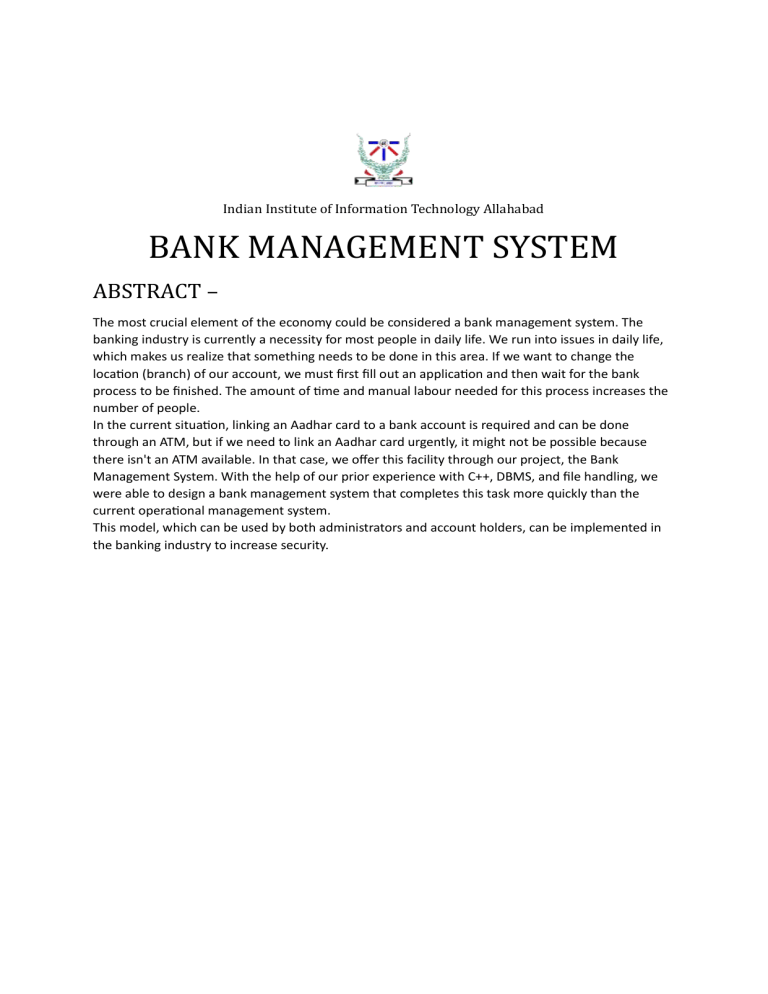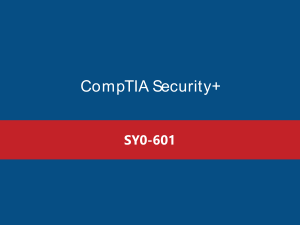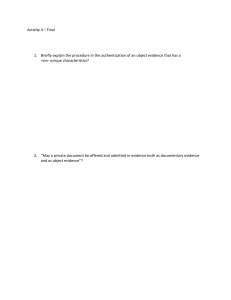
Indian Institute of Information Technology Allahabad BANK MANAGEMENT SYSTEM ABSTRACT – The most crucial element of the economy could be considered a bank management system. The banking industry is currently a necessity for most people in daily life. We run into issues in daily life, which makes us realize that something needs to be done in this area. If we want to change the location (branch) of our account, we must first fill out an application and then wait for the bank process to be finished. The amount of time and manual labour needed for this process increases the number of people. In the current situation, linking an Aadhar card to a bank account is required and can be done through an ATM, but if we need to link an Aadhar card urgently, it might not be possible because there isn't an ATM available. In that case, we offer this facility through our project, the Bank Management System. With the help of our prior experience with C++, DBMS, and file handling, we were able to design a bank management system that completes this task more quickly than the current operational management system. This model, which can be used by both administrators and account holders, can be implemented in the banking industry to increase security. With the help of this project we are solving the problems listed below1)Decentralization of management among the posts like admin and account holders Decentralization facilitates more efficient use of local information but also can lead to agency problems and commitment failures. This paper develops simple models of a two-tier hierarchy (the center vs. the local) to study the optimal division of lending authority between central and local bank managers. Using a unique data set collected by the authors from a survey of rural financial institutions in China, we empirically assess the determinants of decentralization. We find that concerns over agency problems (collusion and government influence) and especially commitment failures (excessive refinancing) explain the recent trend toward centralization of lending authority. We conclude that the inability of financial systems to exploit local information in weak institutional environments may substantially limit the efficiency of intermediation despite financial market liberalization. 2)Aadhar problem solutionAadhaar is a national identity project, but we believe that the subtle difference between identity verification and authentication is itself not well understood, and this leads to confusions in policy making and deployment. Below, we attempt to first demarcate the two concepts. According to standard notions of digital authentication, a security principal (a user or a computer),while requesting access to a service, must provide two independent pieces of information - identity and authentication. Whereas identity provides an answer to the question “who are you?”, authentication is a challenge-response process that provides a “proof of the claim of identity”, typically using an authentication credential. Common examples of identity are User ID (Login ID), cryptographic public keys, email ids, ATM or smart cards; some common authentication credentials are passwords (including OTPs), PINs and cryptographic private keys. Identity may be considered public information but an authentication credential must necessarily be private - a secret that is known only to the user. Moreover, authentication must be a conscious process that requires active participation by a user, but not necessarily so for identity verification. As example use cases a bank may want an identity verification while opening an account at which stage no secret like a password is usually necessary, but a user needs to authenticate with a PIN for transactions like ATM withdrawals. No publicly known information should be used as an authentication credential . 3)OTP security The use of passwords for user authentication has become ubiquitous in our everyday lives. However, password theft is becoming a common occurrence due to a variety of security problems associated with passwords. As such, many organizations are moving towards adopting alternative solutions like one-time passwords, which are only valid for a single session. Nevertheless, various one-time password schemes also suffer from a number of drawbacks in terms of their method of generation or delivery. This paper presents the design of a challenge-response visual one-time password authentication scheme that is to be used in conjunction with the camera on a mobile device. The main purpose of the proposed scheme is to be able to send a challenge over a public channel for a user to obtain a session key, while safeguarding the user’s long-term secret key. In this paper, we present the authentication protocol, the various design considerations and the advantages provided by the scheme.

